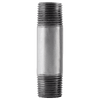Iron Pipe Fittings
Iron pipe fittings are commonly used in plumbing and piping systems to connect and redirect the flow of fluids, primarily water and gas. These fittings are typically made of cast iron or malleable iron and come in various shapes and sizes to accommodate different piping configurations.
Some common iron pipe fittings include:
-
Joining pipes: Iron pipe fittings are used to connect two or more pipes together. They enable the installation of a complete piping network by creating secure and leak-free connections. These fittings include couplings, unions, and flanges.
-
Changing direction: Iron pipe fittings allow for changes in the direction of fluid flow within a piping system. For example, elbows (90-degree or 45-degree) are used to redirect the flow around corners or obstacles.
-
Branching and splitting: T-shaped fittings, such as tees and crosses, are used to create branches or splits in the piping system. They enable the connection of additional pipes to the main line, allowing for the distribution of fluids to multiple locations.
-
Controlling flow: Iron pipe fittings can be equipped with valves, such as gate valves, globe valves, or ball valves, to control the flow of fluids. Valves can be opened or closed to regulate the amount of fluid passing through the system.
-
Reducing or increasing pipe size: Iron pipe fittings include reducers and increasers, which are used to transition between pipes of different diameters. They ensure a smooth and gradual change in pipe size, preventing disruptions in flow.
-
Connecting different materials: Iron pipe fittings can be used to connect iron pipes to pipes made of other materials, such as copper, PVC, or galvanized steel. Adapters or transition fittings are employed for this purpose.
Iron pipe fittings provide versatility and reliability in plumbing and piping systems, enabling efficient fluid transportation, distribution, and control.











